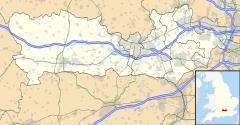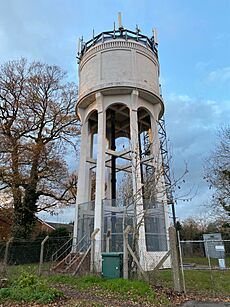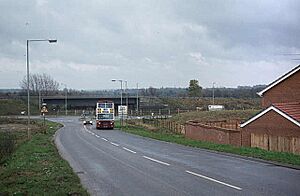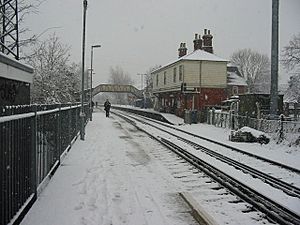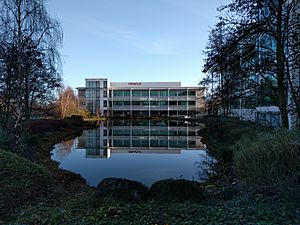Earley facts for kids
Quick facts for kids Earley |
|
|---|---|
| Town and civil parish | |
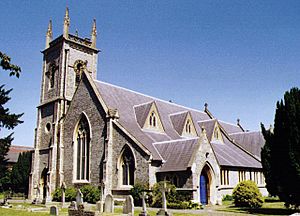 St Peter's Church |
|
| Population | 32,036 (2001) 30,868 (2011 Census) |
| OS grid reference | SU7571 |
| Civil parish |
|
| Unitary authority |
|
| Ceremonial county | |
| Region | |
| Country | England |
| Sovereign state | United Kingdom |
| Post town | READING |
| Postcode district | RG6 |
| Dialling code | 0118 |
| Police | Thames Valley |
| Fire | Royal Berkshire |
| Ambulance | South Central |
| EU Parliament | South East England |
| UK Parliament |
|
Earley (![]() i/ˈɜːrli/ UR-lee) is a town and civil parish in the Borough of Wokingham, Berkshire, England. It is near the town of Woodley. Earley is part of the larger Reading/Wokingham Urban Area.
i/ˈɜːrli/ UR-lee) is a town and civil parish in the Borough of Wokingham, Berkshire, England. It is near the town of Woodley. Earley is part of the larger Reading/Wokingham Urban Area.
For local government, Earley is in the Borough of Wokingham. It is not part of Reading Borough Council. Earley is sometimes spelled Erleigh or Erlegh. It includes smaller areas like Maiden Erlegh and Lower Earley. The town is about 3 miles (5 km) south and east of Reading. It is also about 4 miles (6 km) northwest of Wokingham. In 2011, Earley had about 32,036 people living there.
The main campus of the University of Reading, called Whiteknights Park, is partly in Earley. The other part is in Reading.
Contents
History of Earley
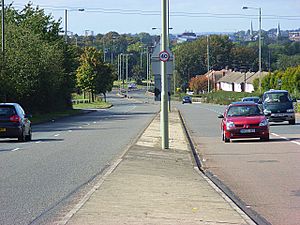
People have lived in the Earley area for a very long time. Stone tools like hand axes have been found here. These tools are from the Paleolithic period, which was about 35,000 years ago. Traces of old shelters from the Mesolithic period were found near Thames Valley Park. Tools from that time were also discovered. Evidence of people living here during the Bronze Age and Iron Age was found too. Even Roman remains have been found in Earley.
Earley is mentioned in the Domesday Book as "Herlei." This was a survey of England made in 1086. It had two main manors (large estates): Erleigh St Bartholomew and Erleigh St Nicolas. The Erlegh family, who were knights, owned these manors for a long time. One of them, John de Erlegh, was known as the White Knight. This is why Erleigh St Nicolas was later called Whiteknights.
The Whiteknights estate was later owned by the Englefield family. Then, the Marquis of Blandford, who became the 5th Duke of Marlborough, owned it.
Another manor, Maiden Erlegh, was created in 1368. It was later owned by different families. In 1878, John Hargreaves bought it. He created a racecourse there for horse races. The grandstand (where people watched races) was later moved to Newbury Racecourse.
In 1903, a rich businessman named Solly Joel bought the Maiden Erlegh estate. He also had a racecourse there. Solly Joel gave some of his land to the village for sports. This park, called Sol Joel Park, was opened in 1927 by the Duke of York (who later became George VI).
Earley's boundaries have changed over time. In 1887, part of Earley became part of the borough of Reading. This area included the main village of Earley. However, the village school and St Peter's church stayed in Earley.
The University of Reading started as a college in 1892. It became a university in 1926. In 1947, it got its new site, which is partly in Earley. Many of the large houses on the university estate were designed by Alfred Waterhouse.
Earley grew a lot before and after World War II. In 1974, it was officially named a town. From 1977, a large housing area called Lower Earley was built. This almost doubled Earley's population. New schools, a supermarket, and a sports centre were built. In 1988, another shopping area called Maiden Place opened.
Some old buildings in Earley are "listed" by English Heritage. This means they are special and protected. For example, Foxhill House on the Whiteknights Campus is a Grade II* listed building. Other listed buildings include old cottages, an inn, and the Church of St Peter.
Geography of Earley
Earley is located in Berkshire, England. It is bordered by different roads and natural features. To the south and southeast, it is bordered by the B3270 road. The boundary then follows the railway line. To the north, the River Thames forms part of the boundary. The River Kennet is also nearby.
The Borough of Reading is to the west of Earley. Woodley is to the northeast. Winnersh is to the east. Arborfield and Shinfield are to the south.
Lower Earley is a large housing area at the southern end of the town. It is often thought of as a separate town. However, it is actually part of Earley. The name Lower Earley is very old. It used to describe the low-lying land near the River Loddon.
Governance in Earley
Earley is part of the new parliamentary constituency called Earley and Woodley. A parliamentary constituency is an area that elects one person to represent it in the UK Parliament. Before this, Earley was mostly in the Wokingham constituency.
Earley used to be a small area within the parish of Sonning. It became its own church parish in 1854. Later, it became a civil parish.
Earley has two levels of local government. The first is Earley Town Council. This council was created in 1974. It is based at Radstock House. The second level is Wokingham Borough Council. This council is based in Wokingham.
There are 25 councillors on the Town Council. They represent eight different areas called wards. There are also 12 Borough Councillors from Earley. They represent four Earley wards on the Borough Council. Town Council elections happen every four years.
Amenities in Earley
Earley Town Council manages several parks and facilities. These include Sol Joel Park, Meadow Park, and Bulmershe Park. They also manage a BMX track and two community centres. Maiden Erlegh Lakes is a local nature reserve managed by the council.
The council also has a large allotment site for gardening. They also run a cemetery. Earley has bus shelters at the main bus stops. The council operates the Waterside Centre, which is a canoe centre. They also run the Loddon Valley Leisure Centre.
Earley has some old woodlands. These include Pearman's Copse and Redhatch Copse. These areas are important for nature.
Transport in Earley
Earley railway station connects the town to Reading and London Waterloo. Winnersh Triangle station is also nearby.
Reading Buses provides many bus services in Earley. Buses connect Earley to the centre of Reading. Some bus routes run 24 hours a day. You can also reach Wokingham by bus or train from Earley.
Earley is located north of the M4 motorway. This major road connects London with Bristol.
Economy of Earley
Earley is home to Thames Valley Park. This business park is next to the River Thames. Many big companies have offices here. These include the UK headquarters of Microsoft and ING Direct. Other companies like Oracle Corporation and Computacenter also have offices here.
The nearby Suttons Business Park also has many service and tech companies. These include Rentokil Initial and Royal Mail.
One important company that used to be in Earley was Sutton Seeds. This was a well-known seed company. Earley was also chosen for an important power station during World War II. It later had a new type of gas turbine electricity generator.
Education in Earley
Earley has six primary schools. These are Aldryngton, Earley St Peters, Hillside, Radstock, Whiteknights, and Hawkedon.
There is one coeducational secondary school called Maiden Erlegh School. Children from Earley also attend other secondary schools. These include The Emmbrook School, Forest School, The Holt School, and The Piggott School.
Religion in Earley
Earley has several places of worship. The main church is Earley St Peter's in Church Road. Trinity Church is a partnership between the Methodist, United Reformed, and Anglican churches. St Nicholas is another Anglican church.
The Baptist church is in Maiden Place. The Roman Catholic church of Our Lady of Peace & Blessed Dominic Barberi is on Wokingham Road. There are also several mosques and a Gurdwara (Sikh temple) in Earley.
Notable people from Earley
Many interesting people have lived in Earley.
- Henry Addington, Viscount Sidmouth (1757–1844): He was a Speaker of Parliament and a Prime Minister. He owned Erleigh Court and helped establish St Peter's Church.
- George Spencer-Churchill, 5th Duke of Marlborough: He acquired the Whiteknights estate in 1798.
- John of Earley (fl. 1180–1215): He was a knight who served William Marshal.
- Isaac Goldsmid, 1st Baronet (1778–1859): He was a financier and the first Jewish Baronet. He owned Whiteknights Estate.
- Baron Hirst (1863–1943): He lived at Foxhill House. He helped found a company that became GEC.
- Rufus Isaacs, 1st Marquess of Reading (1860-1935): He was a Member of Parliament (MP) and a diplomat. He lived at Foxhill House.
- Solomon Joel (1865–1931): A famous businessman who owned the Maiden Erlegh estate.
- General Sir Richard Denis Kelly (1815–1897): A British Army officer who lived in Earley.
- Alfred Waterhouse (1813–1905): A famous architect. He designed and owned Foxhill House. He also designed Wokingham and Reading Town Halls.
|


